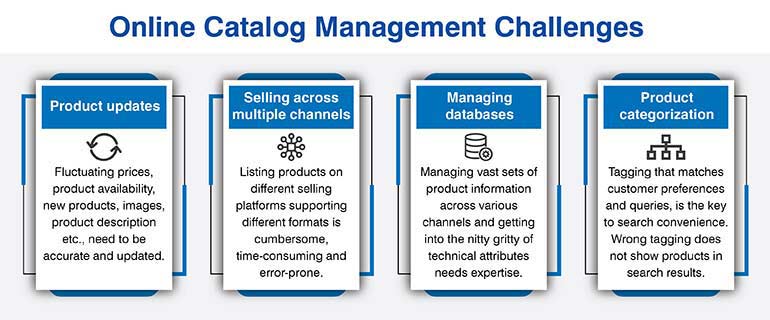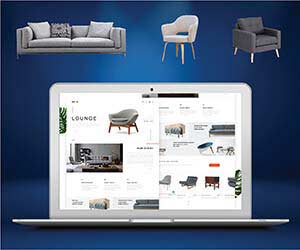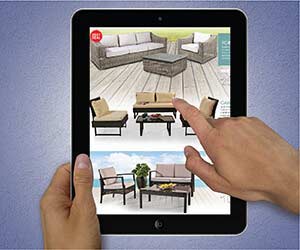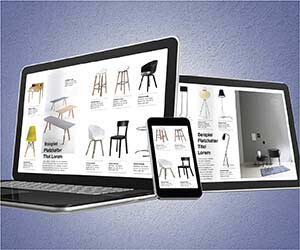10 Powerful eCommerce Data Collection Strategies & Examples
Online furniture catalogs do not only showcase products. From grabbing customer attention to detailing furniture features and making items stand out on product search across channels, furniture retail today depends heavily on online catalog management.
With online stores and marketplaces dominating the growth of furniture sales, omnichannel catalog management has become crucial for furniture brands. Display platforms include online stores on websites, Facebook, Instagram, Google My Business, Etsy, etc. Online marketplaces like Amazon and Walmart and niche online furniture retail portals are also in competition.
The sheer number of channels, and rules that have to be complied with have made online furniture catalog management a complex affair. But it is equally critical as it fuels sales opportunities.
Slow catalog performance, poor product descriptions, limited usage of product attributes for search filters, ineffective SEO, and poor data management can frustrate your online marketing efforts. And, proper catalog management is the key to addressing them. High performing, visually captivating and information-rich furniture catalogs are driving the online furniture market.
In August 2021, global market research firm Technavio reported that the market for catalog management software can grow by USD 963.55 million during 2021-2025. The information was not surprising, but it underlined the growing significance of online catalog management services.
Armed with intelligent product information management, furniture brands are quickly revamping online marketing strategies around digital catalogs. They are setting up automated channel-specific image modification and catalog compliance to keep shopping cart display and advertisement images and information in sync. But it’s no smooth journey and critical challenges need to be overcome.


Keep your online furniture catalog accurately updated across all channels and at every touchpoint: mobile apps, websites, e-commerce portals, or databases accessed through in-house terminals.
Verify and keep updated all product information, like price, units of measurement, technical attributes, usage info, product description, and other details that help customers make informed buying decisions. Standardized and normalized data gives a uniform shopping experience.
Make sure you have systems in place that update price changes, stock situation and new arrivals. Remove redundant and duplicate data to provide a consistent experience.
Keeping static and dynamic data updated can be a challenge, but outsourcing online catalog management to experts is a standard practice. Data accuracy can meet customer expectations better through use of automation and technologies like OCR, data profiling, robust import/export rules, and by normalizing supplier ERP data.

Communicate with your customers through high quality visual representations, including 2D, 3D and VR formats. Visuals are primary channels of conveying information and influencing choice. Apart from making product pages attractive, they grab customer attention immediately, boosting engagement and conversions.
Studies reveal that shoppers prefer to see more images in item descriptions; it is one of the most important risk-reducing factors for online shopping.
High-quality images create the heart of a furniture catalog. Potential customers evaluate your product on craftsmanship and other features before placing an order, relying to a great extent on just images and their appeal.
Editing and retouching of images has become a standard practice to increase the visual appeal of furniture and variations.
An American furniture retailer improved its online buying experience, achieving an exponential sales growth by digitally improving its product photos. Large volumes of images were enhanced with 3D perspective by forging a winning partnership with an offshore service provider.
Adding 3D product rendering allows inspection of joints, seams, craftsmanship and other details. Choosing 3D rendering over studio photography gives better control over lighting. Images can be changed for seasonal marketing campaigns and shoppers can have customized options.
Demo videos have a good recall value, leading to buying decisions with fewer returns. Instructional videos work well for selling complex products. 3D animation can be used to showcase the versatility of modular furniture.
Show your product from all angles and also show images of each product style and color you have in your store. A zoom feature is a must for all online catalogs. It works especially well for the furniture industry, where a buyer needs to view design intricacies.

Tag and categorize each product in a way that makes them searchable without loss of time. Any lag in your search will lead to abandoned carts affecting conversion and retention. Organize products so that customers get the option to filter, refine and sort product information easily and find the product they are looking for.
According to a Forrester research report, it is important for users to find your product information on the first try. A study revealed that 47% of users give up after just one search and 23% try just a few more searches before moving away. A poorly organized site sells 50 percent less than a well-organized one.
Add as many attributes as possible, like color, size, price, etc. Find all possible search options furniture customers use and create your product tags accordingly. Also ensure that all tags remain consistent for uniform shopping experience.
Want to increase visibility and boost conversions?

On your own online shop, recommend relevant products to open opportunities for upselling and cross-selling and for offering wider choices and options. When submitting on online portals, make sure your product is tagged well enough to show up on related product suggestions. This is one of the most significant features of online catalog display. Way back in 2006, Amazon CEO Jeff Bezos had revealed that 35% of sales were the direct result of cross-sells.
While both upselling and cross-selling can build your brand, your strategy should be to limit your related display to products that add genuine value to main purchases. Irrelevant product display in related categories can shake customer faith.

Personalize and segment your online catalog to scale up conversion. With personalized experiences, 80% of consumers are more likely to purchase, shows recent research by New Epsilon.
Channels like websites, e-commerce portals, social media platforms, and online stores have different limitations and standards. Optimizing your product catalog according to different channels allows a furniture brand to engage with customers on the channels of their preference. One of the most significant jobs of catalog creators for specific channels is to take into account why customers prefer a particular channel, and then align the presentation to meet those expectations.

Catalog personalization helps in strategically posting content and showing relevant variations to customers based on their known or predicted preferences. It can range from product suggestions to cart abandonment mails. Deliver personal experience through product recommendations based on previous purchases, browsing history, demographics, etc. to engage customers better and increase repeat purchases.
A study reveals that 44% of consumers are most likely to repeat a purchase after a personalized experience. 71% showed frustration if the shopping experience was impersonal.

Product catalog management has entered a new phase with multi-channel display and omnichannel marketing follow-ups. Managing multi-channel listings in a single database, along with product images, product variations and multiple product profiles and aliases, has multiple technical requirements.

Furniture manufacturers run the risk of losing customers and falling behind competition if they ignore too many sales challenges. Engrossed in developing and delivering products, many manufacturers lose sight of enticing digital product catalogs to attract more customers. With customer demands increasing every day, and global competition and supply chain complexity on the rise, leveraging CRM has become more important than ever.
Implementing CRM solutions can help furniture manufacturers see enormous ROI and combat catalog management challenges across sales channels. An appropriate solution would go all out for a perfect catalog browsing, search and navigation experience.

With AI and machine learning models now being used in catalog management, meticulous planning of the structure is essential to manage the diverse product catalog data. Navigation of high-volume product catalogs, retrieving and including information from suppliers, allowing teams to function without disruption, managing distribution channels and ensuring data quality requires domain expertise and experience.
Outsourcing the task to catalog management companies is a logical way to get the work done professionally and positively influence purchasing decisions. It frees up your resources to focus on supervision, marketing, sales and the designing and production of furniture. Automated catalog management conducted by experts can enormously speed up and streamline your product listing enrichment and reduce returns, replacements, and refunds.
With the tremendous growth in online retailing industry and the shift in consumer behavior, selling is more about attracting traffic, retaining and converting. With a seemingly endless array of options available, a seamless shopping experience is crucial to win customers. Knowing your customer, offering personalized services, suggesting appropriate products, making your online catalog attractive, keeping data accurate and updated 24/7, all work toward building a great furniture catalog.
What’s next? Message us a brief description of your project.
Our experts will review and get back to you within one business day with free consultation for successful implementation.
Disclaimer:
HitechDigital Solutions LLP and Hitech BPO will never ask for money or commission to offer jobs or projects. In the event you are contacted by any person with job offer in our companies, please reach out to us at info@hitechbpo.com
Leave a Reply